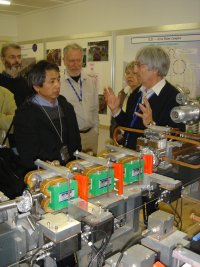 |
 |
|||||||||||||
|
|||||||||||||
|
|||||||||||||
|
After the Large Hadron Collider, the science community agrees that particle physicists will need an electron-positron linear collider to fully understand and discover the potential new science at high energy regimes. Apart from the International Linear Collider - whose 'cold' accelerating technology is based on superconducting radiofrequency cavities – another variant of an electron collider, based on a warm accelerating technology is under study: the Compact Linear Collider Study (CLIC). The two teams held a meeting at CERN on 8 February to investigate the connections between the two projects and to list potential cooperative efforts on common activities. The idea of such a meeting arose last November, when Barry Barish, Director of the ILC Global Design Effort (GDE), met with the CLIC Extended Steering Committee - including CERN GDE members, and with Robert Aymar, CERN Director-General. There, they decided that both project teams should promote joint efforts and fruitful cooperation on subjects with strong synergies. By the end of the month, Jean-Pierre Delahaye, CLIC study leader, and the ILC project managers launched the planning process that led to the first ILC-CLIC collaboration meeting. “There are many reasons to strengthen the links between the CLIC collaboration and the GDE. At the most fundamental level, many scientists and engineers face similar challenges while striving to bring these complex tools to reality,” said Marc Ross, ILC Project Manager. For instance for the beam delivery sub-system - where electron and positron bunches will be collimated and focused with extreme precision, there is already a long history of collaborative work between the two projects. “We hope that in the different sub-systems, the teams will bring a diversity of skills and tools to bear. Bringing them together will not only be educational but also beneficial for both,” said Delahaye. Such cooperation will be very useful for ILC and CLIC where R&D efforts are themselves large international projects. Both the CLIC collaboration, hosted at CERN, and the ILC-GDE rely on in-kind contributions - where participants provide equipment and effort and receive in return a share of the final product, for technical design and development work and for test facility construction. The most important part of the in-kind equation is to be sure that both the overall project and the contributing institution benefit. The final goal of this cooperation is to develop common project tools and plans, together with evaluation tools, which will make it easier to review and compare both when, and if, it becomes necessary to do so. “We need to speak a common language, even if it takes some effort to learn to do so,” said Marc Ross. During the meeting, working groups met in parallel sessions and began talking about how to cooperate. For example, they proposed sharing some of their simulation tools. The meeting was attended also by detector experts from each of the ILC detector concepts, and from the CLIC project. This meeting was the first step toward closer cooperation of the two projects. “That was the first occasion when both communities actually sat together,” said Delahaye. “Now we need to go further, identifying for instance the contact person for each working group and defining action plans for a few areas of strong synergy between the two studies.” In the future, the two teams agreed to participate broadly in major meetings of both projects and to report progress to the ILC Executive Committee and the CLIC Collaboration Board. For the accelerator part, the next appointments will be the Sendai ACFA-GDE meeting from 3 to 6 March and the CERN CLIC08 Workshop from 14 to 17 October. The physics and detector community will have opportunities to exchange information during the next meetings such as the EFCA meeting from 9 to 12 June in Warsaw. -- Perrine Royole-Degieux |
|||||||||||||
| © International Linear Collider |
